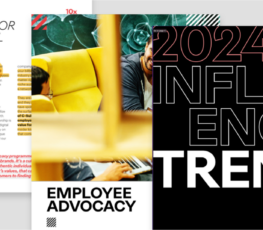If you are not familiar with what we mean by “internal social media,” it is essentially turning your company’s employees into brand advocates and encouraging them to share company content to their social networks.
A more popular and growing term for this is employee advocacy.
In the last few years, the need for an internal social media strategy has begun to grow in popularity and many well-known brands are now investing time and resources into this strategy and social platforms.
Before, your company may have been against allowing employees to share on social media, but the shift in that mindset has changed.
Companies who have guidelines in place but allow employees to participate in online conversations are reaping the benefits in marketing, sales, communications, and even human resources.
If you’ve decided to invite your employees to take part in your business’s internal social media strategy or you’re considering it, you’ve made a smart decision. Your audiences and prospects are actively using social media and those numbers are continuing to grow for each platform.
Additionally, your employees can be huge assets in expanding your customer base, growing your brand reach, and shaping your reputation and image through social.
But before you take the plunge, it’s important to know exactly what you’re getting yourself into – and how to avoid common mistakes that can quickly balloon into costly setbacks to your company’s social media strategy. Here are five things you need to know before jumping in.

Develop an internal social media strategy:
There’s no doubt your business will craft detailed policies that guide how your employees use and interact with your corporate social media accounts, but you also need to develop a true, all-encompassing corporate social media strategy.
Here are the key questions to answer:
- What is your business trying to achieve with this major shift in how you utilize your employees?
- What are the benchmarks of success with your social media plan, and the timeline for achieving these benchmarks?
- How will you evaluate whether your plan is working?
- How will your company decide if and when to alter your plan, and who will make that decision?
Like any new corporate initiative, an internal social media strategy requires proactive thought and deliberation to succeed. Nor should it be rushed for the sake of getting started.
Explain how employees can advance your strategic goals:
If you tell your employees that the goal of your social media initiative is simply to bring more awareness to your company or to build your brand’s image, then you haven’t fully fleshed out your employee advocacy policy well.
You want to be able to explain to your employees exactly what kind of messages you want them to share and how their efforts will fit into overall strategic goals of the company.
For example, you never want to tell your employees something vague like: “We encourage you to share this company post on your Facebook and to write a positive message to go with it.” That gets nothing across, nor builds any excitement to get involved.
You need to be clear about the value employees bring to the goals of the company, but more importantly, how it can also positively affect employees as well (think thought leadership, improving their career, etc.)
A great way to roll out and maintain your social advocacy plan is to utilize an employee advocacy social media sharing platform. It makes it easy for social media managers to curate both third-party content and corporate content for internal social media efforts. Sharing is literally as easy as pushing a button.
Learn how EveryoneSocial can help transform your workforce into a social media powerhouse. Schedule your personal demo.
Know your employees’ legal rights:
Most employees will not willingly tarnish their company’s reputation, but let’s say they post a strong personal opinion at odds with the company’s stance, or inadvertently divulge intellectual property, or engage with a journalist without realizing they’re de-facto speaking on behalf of the company.
You must know the legal limits for how you can discipline employees who create these kinds of headaches for your company on social media.
In general, personal social media usage is considered free speech, up to the point that an employee is being “disloyal” and can be shown to be deliberately driving away customers. This is a high burden of proof for the employer and can quickly become legally messy.
Rather than let a situation escalate to this level, you should set clear expectations now for things like preventing the release of privileged information, stating strong personal opinions, and interacting with reporters and bloggers on social media.
Keep track of who and what devices have access:
There is nothing worse than having your corporate social media account hacked. As a general rule, you should update the list of employees who are authorized to log into your corporate social media accounts about once a week; you also should frequently change passwords.
While you should aim to have lots of employees who can write content for your corporate social media accounts, you should only have a few with the ability to post to them.
That’s why the concept of employee advocacy is so important. Instead, employees leverage their own social accounts, share company content on their time, and still contribute to the overall messaging of the brand without compromising the corporate social handles.
Accelerate a positive work culture:
If your company’s work culture is not great or employees distrust their leaders, getting employees active in internal social media marketing should not even be a thought.
Because social media is not something you require employees to do but encourage them to get involved, this is something they’ll have to want to do.
If your company only sees employees as dollar signs and not getting them more involved, why would employees go above and beyond?
People love sharing about their company, their jobs, their industry, and what cool things their company is doing. If your company is not pushing for a great work culture, employees do not have a reason to get excited about their work or want to even let others know.
Although you may have interest in employee advocacy, it is not something you implement as a patch to bad culture and hope employees share on social media. Make sure the work culture is positive and make changes if need before any internal social media strategy is in place.
Final Thoughts
Your employees want to generally do right by you on social media – that’s why you hired them and that’s why your corporate social media strategy can and will succeed.
Just remember that before you unleash them on social media, you must develop an integrated strategy that considers the employees’ contributions in light of strategic goals, and you must understand your employees’ free-speech rights.
But more importantly, work on promoting a positive work culture that employees get excited about. They’ll be much more interested in getting involved in social conversations and being your brand advocates.
EveryoneSocial is used by companies across a range of industries in over 60 countries across the globe to get their employees active on social media. Check out some companies utilizing our platform for an internal social media strategy.
















